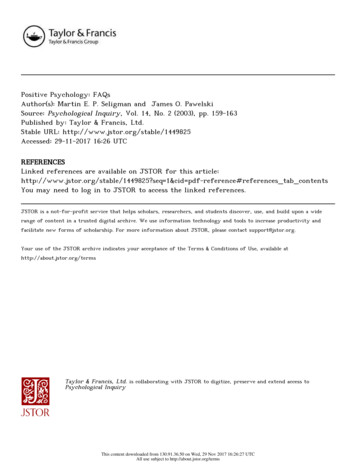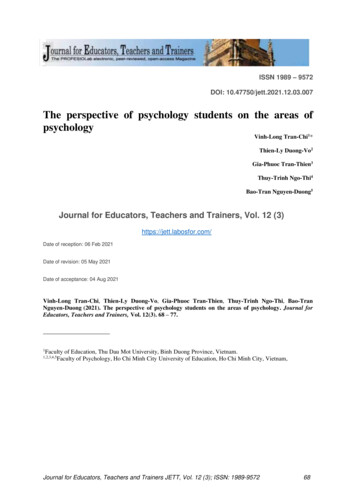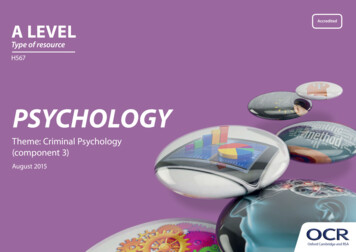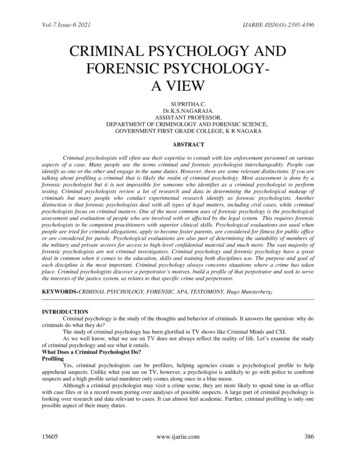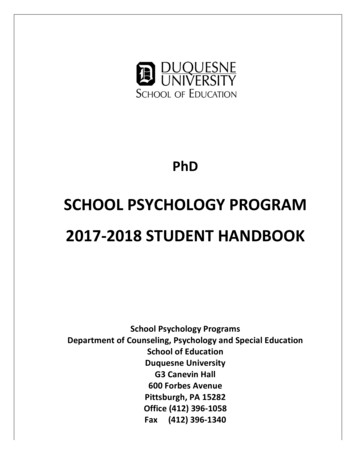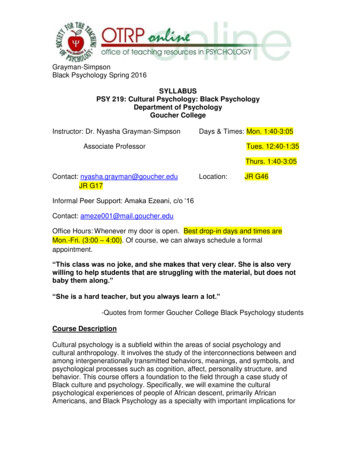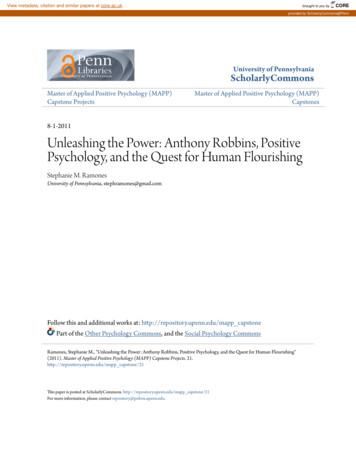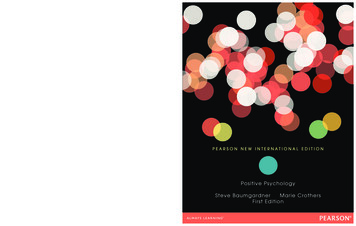
Transcription
Positive PsychologyBaumgardnerCrothersFirst EditionPositive PsychologyISBN 978-1-29203-961-99 781292 039619Steve BaumgardnerMarie CrothersFirst Edition
Pearson New International EditionPositive PsychologySteve Baumgardner Marie CrothersFirst Edition
Pearson Education LimitedEdinburgh GateHarlowEssex CM20 2JEEngland and Associated Companies throughout the worldVisit us on the World Wide Web at: www.pearsoned.co.uk Pearson Education Limited 2014All rights reserved. No part of this publication may be reproduced, stored in a retrieval system, or transmittedin any form or by any means, electronic, mechanical, photocopying, recording or otherwise, without either theprior written permission of the publisher or a licence permitting restricted copying in the United Kingdomissued by the Copyright Licensing Agency Ltd, Saffron House, 6–10 Kirby Street, London EC1N 8TS.All trademarks used herein are the property of their respective owners. The use of any trademarkin this text does not vest in the author or publisher any trademark ownership rights in suchtrademarks, nor does the use of such trademarks imply any affiliation with or endorsement of thisbook by such owners.ISBN 10: 1-292-03961-2ISBN 10: 1-269-37450-8ISBN 13: 978-1-292-03961-9ISBN 13: 978-1-269-37450-7British Library Cataloguing-in-Publication DataA catalogue record for this book is available from the British LibraryPrinted in the United States of America
PEAR SO NC US T OMLIBRAR YTable of Contents1. What is Positive Psychology?Steve R. Baumgardner/Marie K. Crothers12. The Meaning and Measure of HappinessSteve R. Baumgardner/Marie K. Crothers153. Positive Emotions and Well-BeingSteve R. Baumgardner/Marie K. Crothers414. ResilienceSteve R. Baumgardner/Marie K. Crothers615. Happiness and the Facts of LifeSteve R. Baumgardner/Marie K. Crothers796. Money, Happiness and CultureSteve R. Baumgardner/Marie K. Crothers1057. Personal Goals as Windows to Well BeingSteve R. Baumgardner/Marie K. Crothers1338. Self-Regulation and ControlSteve R. Baumgardner/Marie K. Crothers1619. Positive TraitsSteve R. Baumgardner/Marie K. Crothers18510. Virtue and Strengths of CharacterSteve R. Baumgardner/Marie K. Crothers21711. Close Relationships and Well-BeingSteve R. Baumgardner/Marie K. Crothers249ReferencesSteve R. Baumgardner/Marie K. Crothers279Index311I
II
What Is Positive Psychology?CHAPTER OUTLINETraditional PsychologyWhy the Negative Focus?Negative Aspects Perceived as More Authentic and “Real”Negatives as More ImportantThe Disease ModelPositive PsychologyHealth PsychologyFocus on Research: Living Longer Through Positive Emotions—The Nun StudyClinical PsychologyDevelopmental PsychologySurvey Research and Subjective Well-BeingSocial/Personality Psychology and the Psychology of ReligionPositive Psychology:Assumptions, Goals, and DefinitionsLife Above ZeroCulture and the Meaning of a Good LifeWhy Now?Two Final NotesPositive Psychology Is Not Opposed to PsychologyPositive Psychology and the Status QuoTRADITIONAL PSYCHOLOGYMy major professor used to say that the surest way to become famous in psychology was topublish a study showing that human nature is even worse than we had imagined. His pointwas not to impugn the integrity of anyone who conducted such a study, but rather to notepeople’s fascination with the dark side of human nature. A case in point is the one study thatnearly every college student in introductory psychology remembers, namely StanleyMilgram’s (1974) famous research on obedience to authority. In Milgram’s study, ordinarypeople delivered what they believed to be painful electric shocks to a middle-aged man ashe made errors on a simple learning task. At the direction of a white-coated lab technician,people increased the level of “shocks” despite strident protests from the recipient. Theseprotests included refusals to continue the experiment, agonizing screams, demands that hebe let out of the study, and complaints that his heart was starting to bother him. The participants were visibly upset by the effects on the victim of what they believed to be genuineelectric shocks. However, 66% still obeyed the commands of the experimenter, marched upthe shock scale, and pulled the last switch at the highest shock level of 450 volts, despiteclear markings on the control panel indicating that the shocks were dangerous. How bad isFrom Chapter 1 of Positive Psychology, First Edition. Steve R. Baumgardner, Marie K. Crothers.Copyright 2009 by Pearson Education, Inc. All rights reserved.1
What Is Positive Psychology?human nature? Milgram’s classic study suggests thatordinary people will go against their own judgmentand moral values under minimal pressure froma legitimate authority. Human nature, it appears,cannot be counted upon to insulate society fromacts of brutality.The connections between the Milgram studyand real-life cases of people following orders tocommit acts of brutality are compelling. AdolphEichman, tried for crimes against humanity for hispart in the Holocaust death camps run by theNazis in World War II, said repeatedly in his owndefense that he was just following orders.Captured in philosopher Hanna Arendt’s famousphrase, “the banality of evil” (1963), those whocarried out extraordinary acts of brutality in thesystematic killing of Jews were utterly ordinarypeople—not pathological monsters. Like participants in Milgram’s study, they were just followingorders.A positive psychologist might ask, why aren’tthere equally dramatic studies showing the humancapacity for goodness? It certainly is not becausegoodness does not exist in the world. History provides countless examples. People risked their lives tohelp Jews escape from Nazi Germany during WorldWar II, and priests and ministers aboard the Titanicsacrificed their own lives for others by giving theirlife preservers to fellow passengers. And, who canforget the imagery of heroic firefighters, police officers, and ordinary citizens following the September 11terrorist attacks? A basic positive psychology premise is that the field of psychology is out of balance,with more focus on the negatives in human behaviorthan on the positives. Positive psychology does notdeny the negative, nor does it suggest that all ofpsychology focuses on the negative. Rather, thenew and emerging perspective of positive psychology embraces a more realistic and balanced view ofhuman nature that includes human strengthsand virtues without denying human weakness andcapacity for evil. Each of us confronts a share ofsadness and trauma in our life; but we also experience our share of joy and happiness. Historically,psychology has had more to say about the downsthan about the ups. A large number of college students complete a general psychology course as partof their college education. Studies show that theyrecall mostly the negatives of human behavior, suchas mental illness and the Milgram study (seeFineburg, 2004, for a review). Positive psychology2aims to offset this negative image of human naturewith a more balanced view.Why the Negative Focus?NEGATIVE ASPECTS PERCEIVED AS MORE AUTHENTICAND “REAL” Sigmund Freud is perhaps too easy atarget for criticism regarding psychology’s emphasison negatives. Yet undoubtedly, Freud was influentialin promoting the belief that beneath the veneer ofeveryday politeness and kindness lurked more selfserving motives. Let’s say you sacrifice some of yourown study time to help your roommate with a difficult homework assignment. Looks positive and altruistic on the surface, but some would argue that inactuality, you are just expressing your need to dominate and feel superior to others. You give blood at auniversity blood drive, but in actuality you weremotivated by sexual attraction to one of the blooddrive volunteers. You commit your life to helpingothers for low pay, but Freud might argue that youare just trying to compensate for feelings of inadequacy and guilt caused by traumatic childhood experiences. Freud believed that human behavior ismotivated primarily by self-serving drives that mustbe controlled and channeled in productive ways forsociety to function effectively. Freud did not necessarily believe self-serving behaviors were bad. Fromhis perspective they simply express our biologicallyinherited needs and impulses. The legacy of Freud’sviews within psychology, however, has been to perperpetuate a negative image of human nature. It is difficult to deny that behaviors and traits that areseemingly positive on the surface are sometimesrooted in negative motives. However, positive psychology emphasizes that this is not always the case.From a positive psychology perspective, positive qualities and motives are just as authentic as negative onesand they affirm the positive side of human nature.In addition to the Freud-inspired suspicionthat negative motives lie beneath the surface of positive behaviors, there is also a science-inspired skepticism concerning the scientific legitimacy of topicsstudied in positive psychology—topics that someperceive as reminiscent of the popular psychologyliterature. Historically, psychologists have used poppsychology and self-help books as examples of thefolly of unscientific and empirically unsupportedideas about human behavior. Many psychologistsview the success of the self-help industry as evidence of laypersons’ gullibility and the importance
What Is Positive Psychology?of a critical scientific attitude. Telling an empiricallyminded psychologist that his or her research smacksof pop psych would be an extremely disparagingcriticism.One of my students gave the following description of positive psychology: “Positive psychology ispop psychology with a scientific basis.” The student’sdescription is insightful because it acknowledges theconnections between the subject matter of positivepsychology and many long-standing mainstays ofpop psychology. Current topics in positive-psychologyinclude the study of happiness, love, hope, forgiveness, positive growth after trauma, and the healthpromoting benefits of a positive, optimistic attitude.These topics read like a rundown of books in the poppsych section of your local bookstore. In summary,two reasons for psychology’s greater focus on negative than positive phenomena are rooted in negativebeliefs about the basic nature of humanity, and skepticism about the scientific basis of positive psychology’s subject matter.NEGATIVES AS MORE IMPORTANT Ironically, researchsuggests that the greater weight and attention given tothe negatives in human behavior compared to the positives may reflect a universal tendency (i.e., such afocus may be inherent in human nature). Generally, inhuman behavior the “bad is stronger than thegood” (Baumeister, Bratslavsky, Finkenauer, & Vohs,2001). Studies of impression formation show that information about negative traits and behaviors contributesmore to how we think about others than does positiveinformation—a finding dubbed the “trait negativitybias” (Covert & Reeder, 1990; Rozin & Royzman,2001). Research has also shown that the presence ofconflict and negative behavior makes a greater contribution to relationship satisfaction (or lack thereof) thandoes the amount of positive behavior (Reis & Gable,2003). Studies strongly suggest that one negative comment can undo many acts of kindness and one badtrait can undermine a person’s reputation.Part of the reason for the power of the negative is that we seem to assume that life is generallygoing to be good, or at least ok. This assumptionmay reflect our everyday experience, in whichgood or neutral events are more frequent than badones. As a result, negative events and informationstand out in distinct contrast to our general expectations. Research supports this idea that becausepositive events are more common in our experience, negative ones violate our expectations andare consequently given more attention (Gable &Haidt, 2005).The fact that we attend more to the “bad” thanto the “good” may also reflect an adaptive evolutionary behavior (Reis & Gable, 2003). Aversive eventsand negative behaviors may represent threats to oursurvival, therefore justifying, in an evolutionary survival sense, greater attention and impact. Evolutionmay thus help explain the “attention-grabbing powerof negative social information” described by Prattoand John (1991). So, another reason for psychology’sfocus on the negative may be that psychologists aresimply human, studying what attracts the greatestattention and what has the greatest impact on humanbehavior.THE DISEASE MODEL Martin Seligman (2002a, 2002b,2003) argues that the dominance of the disease modelwithin psychology has focused the field on treating illness and away from building strengths. The diseasemodel has produced many successes in treating psychopathology. Based on the disease model, psychology has built an extensive understanding of mentalillness and a language to describe the various pathologies that affect millions of people. However, Ryff andSinger (1998) argue that psychology should be morethan a “repair shop” for broken lives. The diseasemodel is of limited value when it comes to promotinghealth and preventing illness. Psychologists know farless about mental health than about mental illness. Welack a comparable understanding or even a languagefor describing the characteristics of mentally healthypeople; yet it is clear that mental health is not simplythe absence of mental illness. Eliminating illness doesnot ensure a healthy, thriving, and competent individual. This fact points out that another contributor topsychology’s focus on the negative has been the wellintentioned desire to reduce human misery, guided bythe disease model.POSITIVE PSYCHOLOGYMartin Seligman may have been the first contemporary psychologist to call this new perspective “positive psychology.” In his 1998 presidential address tothe American Psychological Association, Seligmanmade a plea for a major shift in psychology’s focus(Seligman, l998), from studying and trying to undothe worst in human behavior to studying and promoting the best in human behavior. He asked his3
What Is Positive Psychology?audience why psychology shouldn’t study thingslike “joy and courage.” Seligman supported his callfor positive psychology by noting the imbalance inpsychology we discussed earlier: too much attention to weaknesses and reducing human misery,and not enough attention to strengths and promoting health. Seligman’s hope was that positivepsychology would help expand the scope of psychology beyond the disease model to promote thestudy and understanding of healthy human functioning. The standing ovation at the close of hisaddress indicated an enthusiastic response toSeligman’s ideas.New areas of psychology do not emerge in avacuum. The concerns and perspectives of positivepsychology, given clarifying description by Seligman,have scattered representation throughout psychology’s history. Terman’s (1939) studies of giftedchildren and determinants of happiness in marriage(Terman, Buttenwieser, Ferguson, Johnson, &Wilson, 1938) are early examples of research emphasizing positive characteristics and functioning, asnoted by Seligman and Csikszentmihalyi (2000). Theorigins of research on subjective well-being can befound in early research starting in the 1920s and reinforced by the polling techniques of George Gallupand others (Diener, Lucas, & Oishi, 2002). Withinpsychology’s recent history, the humanistic movement may have been one of the stronger voices for amore positive psychology. Humanistic psychology (apopular perspective in the 1960s) also criticized thetendency of traditional psychology to focus on negative aspects of human functioning. Humanistic psychologists Abraham Maslow and Carl Rogers viewedhuman nature as basically positive, insisting thatevery individual is born with positive inner potentials, and that the driving force in life is to actualizethese potentials. Humanistic psychologists believedthat the goal of psychology should be to study andpromote conditions that help people achieve productive and healthy lives.What is new about positive psychology,however, is the amount of research and theory ithas generated, and the scientific respectability ithas achieved. Psychologists can now study hope,forgiveness, or the physical and emotional benefitsof positive emotions without feeling that theyare leaving their scientific sensibilities behind,and without being regarded as pop psychologists.One may still receive some good-natured ribbing,however. For example, one of our colleagues4refers to your first author’s positive psychologyclass as “the happiness course.”While there is no official or universallyaccepted definition, positive psychology draws onresearch and theory from established areas of psychology. Positive psychology is, in part, a mosaic ofresearch and theory from many different areas ofpsychology tied together by their focus on positiveaspects of human behavior. Below is a brief sketchof research and theory from different areas of psychology that have contributed most to positive psychology. Hopefully, an overview of its relationshipto more established and familiar areas of psychologywill clarify what positive psychology is about.Health PsychologyPositive psychology and health psychologyshare much in common (Taylor & Sherman, 2004).Health psychologists have long suspected that negative emotions can make us sick and positive emotions can be beneficial. However, only recently hasa scientific and biological foundation been developed for these long-standing assumptions. Ourunderstanding of the relationship between bodyand mind has advanced dramatically in the last several decades. Research findings affirm the potentialhealth-threatening effects of stress, anger, resentment, anxiety, and worry (Cohen & Rodriguez, 1995;Friedman & Booth-Kewley, 1987; Salovey, Rothman,& Rodin, 1998; Taylor, 1999; Vaillant, 1997, 2000).The pathways and mechanisms involved are complex and are just beginning to be understood. Theyinvolve the brain, the nervous system, the endocrinesystem, and the immune system (Maier, Watkins, &Fleshner, 1994). A variety of research shows thatpeople going through long periods of extreme stressare more vulnerable to illness (Cohen, 2002; KiecoltGlaser & Glaser, 1987; Ray, 2004; Vaillant, 1997). Onereason that stress and negative emotions are bad forus is that they seem to suppress the functioning ofthe immune system and reduce our body’s ability tofight disease.Positive psychologists are very interested in themost recent studies suggesting that positive emotionsmay have effects equal to negative emotions, but inthe opposite direction. While negative emotionscompromise our health, positive emotions seem tohelp restore or preserve the health of both our mindsand our bodies. Positive emotions appear to set inmotion a number of physical, psychological, and
What Is Positive Psychology?social processes that enhance our physical wellbeing, emotional health, coping skills, and intellectual functioning. Summarized in Fredrickson’s (2001)broaden-and-build theory, positive emotions like joy,contentment, interest, love, and pride “all share theability to broaden people’s thought-action repertoires and build their enduring personal resources,ranging from physical and intellectual resources tosocial and psychological resources” (p. 219).Our increasing knowledge of the physiologicalprocesses underlying emotions provides a biologicalfoundation for positive psychology. It seems reasonable to conclude that positive emotions have everybit as much biological and evolutionary significanceas the negative emotions that have attracted somuch research attention. Consistent with the goal ofrestoring balance to the field, positive psychologyemphasizes examination of the value of positiveemotions in our lives.Focus on Research: LivingLonger Through PositiveEmotions—The Nun StudyDo people who experience an abundance of positive emotions in their lives—emotions like cheerfulness, joy, and contentment—live longer than thosewhose emotional lives are less positive? Sounds reasonable, but how could you untangle all the complex factors that affect people’s health to show thatemotions made the difference? The “Nun Study,”perhaps destined to become a classic in positivepsychology, took advantage of the unique featuresof the religious life of sisters of the Catholic Church.The Nun Study was conducted by Danner, Snowdon,Friesen (2001) from the University of Kentucky. Thestudy’s formal title was “Positive emotions in earlylife and longevity: Findings from the Nun Study.”Danner and her colleagues examined the relationship between positive emotions and longevity in asample of 180 nuns. Why nuns? Nuns were anideal group of people for such a study because manyof the factors affecting physical health were controlled or minimized. Nuns don’t smoke or drinkexcessively; they live in similar life circumstances;they are childless, so they have the same reproductive histories; and they eat the same bland diet. The“sameness” of their lives eliminated many of thevariables that might confound an understandingof which specific factors were responsible for along life.What led the researchers to believe that a person’s emotional life might predict longevity? First ofall, prior research (reviewed in the article’s introduction) supports the connection between emotions andhealth. Negative emotions have been shown to suppress the immune system and other aspects of physiological functioning and thereby increase the risk ofdisease. Positive emotions seem to enhance thesesame processes and thus reduce the risk of disease.Second, temperament has shown long-term stabilityover the life span. That is, emotional expressiveness,such as whether we have a positive and cheerful outlook or a negative and more guarded outlook, tendsto be fairly consistent over a person’s lifetime, fromchildhood through adulthood. Third, temperament isknown to influence how well a person copes withthe stress and challenges of life. People with cheerfultemperaments and positive outlooks fare better thanthose with less cheerful and more negative outlooks.Finally, research has shown that writing about significant life events can capture a person’s basic emotional outlook. When we write about things that areimportant to us, we express emotions that reflectaspects of our basic temperament. Taken together,these findings of prior research made it reasonable toassume that autobiographies written early in lifewould capture basic aspects of emotional expressiveness. Differences in emotional expressiveness mightthen predict health and longevity.The nuns in Danner and colleagues’ study hadbeen asked to write a brief 2- to 3-page autobiographical sketch as part of their religious vows.These sketches were written in the 1930s and 1940swhen the sisters were about 22 years old and justbeginning their careers with the church. Researcherswere able to retrieve the autobiographies fromchurch archives. Then, they coded each autobiography by counting the number of positive-, negative-,and neutral-emotion words and sentences that itcontained. Because few of the autobiographies contained negative emotions, the researchers concentrated on the number of positive-emotion words,positive-emotion sentences, and the number of different positive emotions expressed. Here are twosample portions of autobiographies—one low in positive emotion and the other high in positive emotion.Sister A—coded as low in positive emotion:I was born on September 26, 1909, theeldest of seven children, five girls and twoboys . . . . My candidate year was spent in5
What Is Positive Psychology?the Motherhouse, teaching chemistry andSecond Year at the Notre Dame Institute.With God’s grace, I intend to do my bestfor our order, for the spread of religionand for my personal sanctification.”Sister B—coded as high in positive emotion:God started my life off well by bestowingon me a grace of inestimable value. Thepast year, which I spent as a candidatestudying at Notre Dame College hasbeen a very happy one. Now I look forward with eager joy to receiving theHoly Habit of Our Lady and to a life ofunion with Love Divine.Scores resulting from the coding system provided numeric indices to describe the women’s earlyemotional lives. These scores were then analyzed inrelation to mortality and survival data for the samegroup of women 60 years later. At the time the studywas done in 2001, the surviving nuns were between75 and 94 years of age. Forty-two percent of the sisters had died by the time of the follow-up study.The results of the study were rather amazing.Researchers found a strong relationship betweenlongevity and the expression of positive emotionearly in life. For every 1.0% increase in the numberof autobiographical sentences expressing positiveemotion, there was a corresponding 1.4% decreasein mortality rate. Comparisons of those nuns expressing many different positive emotions with thoseexpressing only a few, showed a mean difference inage of death of 10.7 years. The most cheerful nunslived a full decade longer than the least cheerful! Byage 80, some 60% of the least cheerful group haddied, compared to only 25% for the most cheerfulsisters. The probability of survival to an advancedage was strongly related to the early-life expressionof positive emotions. Figure 1 shows the positiveemotion/survival relationship beginning at age 75.The probability of survival to age 85 was 80% for themost cheerful nuns (Quartile 4 in Figure 1) and1.00.90.8Probability of Survival0.70.60.50.4Quartile 10.30.2Quartile 2Quartile 3Quartile 40.10.0758085Age9095FIGURE 1 Positive Emotions and SurvivalProbability of survival to different ages after age 75 as a function of positive emotions expressedearly in life by 180 participants in the Nun Study. Positive emotional expression arranged in rankorder from lowest (Quartile 1) to highest (Quartile 4). Source: Danner, D.D., Snowdon, D.A.,& Friesen, W.V. (2001). Positive emotions in early life and longevity: Findings from the Nun study.Journal of Personality and Social Psychology, 80, 804–813. Copyright 2001 by the AmericanPsychological Association. Reprinted by permission.6
What Is Positive Psychology?54% for the least cheerful (Quartile 1). The odds ofsurvival to age 90 were 65% for the upbeat sisters,but only 30% for the less upbeat. By age 94, the survival odds were over half (54%) for the most positivesisters and only 15% for the least positive.According to the results of the Nun Study, thephrase, “don’t worry, be happy” is excellent advice.You may live longer!Clinical PsychologyThe disillusionment of many clinical psychologistswith sole reliance on the disease model has beenanother factor contributing to the development ofpositive psychology. Mental health professionals arebeginning to view the work of reducing psychological misery as only part of their task. There willalways be clients in need of help, and it will continue to be an important mission of psychologists toprovide such help. However, many clinicians havebegun shifting from the single-minded purpose oftreating psychopathology toward a perspective thatincludes prevention of illness and promotion of positive mental health. Fundamental to this shift is theneed to develop models of positive mental health.That is, what personal characteristics and what typeof life define the extreme opposite of mental illness—a state Keyes and Haidt (2003) call “flourishing?” Inthe past, mental health was defined mostly in termsof the absence of disease. One goal of positive psychology is to establish criteria and a language defining the presence of mental health that parallels ourcurrent criteria and language for describing anddiagnosing mental illness.Developmental PsychologyA long-standing focus of developmental psychologists has been examination of conditions that threatenhealthy development. Following a deficit-focusedmodel, it was assumed that most children growing upunder conditions of adversity (e.g., poverty, abuse,parental alcoholism, or mental illness) would be atheightened risk for deficits in social, cognitive, andemotional development compared to children notsubjected to such adversities. These assumptionsbegan to change in the 1970s when many psychiatrists and psychologists drew attention to the amazingresilience of certain children and adults subjected topotentially debilitating life challenges (Masten, 2001).Cases of resilience—meaning “good outcomes inspite of serious threats to adaptation or development”(Masten, p. 228) —are more common than previouslysupposed. Research documenting the amazingresilience of ordinary people facing difficult life circumstances highlights a major theme of positive psychology, namely human strengths.Perhaps even more intriguing is the concept ofposttraumatic growth (PTG) as a counterpoint toposttraumatic stress disorder (PTSD). Researchershave documented that positive growth can occur asa result of traumatic experiences like serious illness,loss of a loved one, or a major accident or disability(Ryff & Singer, 2003a). In the aftermath of suchevents, many people report a greater appreciationfor life and their loved ones, an increased sense ofpersonal strength, and more clarity about what ismost important in life. Studies of resilience and posttraumatic growth underscore positive psychology’semphasis on human strengths and positive copingabilities.Survey Research and SubjectiveWell-BeingPublic opinion polling has been a long-standingresearch tool for social psychologists and sociologists. Beginning with national surveys of opinionstoward issues, groups, and political candidates, survey research subsequently branched out to includequality-of-life measures. Ed Diener (2000) is a prominent contemporary researcher who studies happiness, defined as subjective well-being (SWB).Measures of SWB assess a person’s level of life satisfaction and the frequency of positiv
Positive Psychology:Assumptions,Goals,and Definitions Life Above Zero Culture and the Meaning of a Good Life Why Now? Two Final Notes Positive Psychology Is Not Opposed to Psychology Positive Psychology and the Status Quo What Is Positive Psychology? From Chapter 1 of Positive Psychology , First Edition. Steve R. Baumgardner, Marie K. Crothers.

